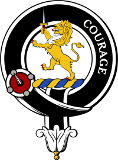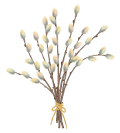Norway, heir to the Scottish throne; however, she died en route to Scotland. This created a crisis that demanded the intervention of King Edward I of England; he was to decide who had the best claim to the throne. The English king decided, correctly, in favor of John Balliol, the brother-in-law of John Comyn. John had married Eleanor Balliol between 1270 and 1283.2 John Balliol was crowned in 1292.
The son of the Black Comyn was John, known as the Red Comyn. This John Comyn was not only a descendant of King Donald Bane, but he also had a claim to the throne based on his descent from King David I. His maternal grandmother was Devorguilla of Galloway. Her mother was Margaret of Huntingdon, the elder sister of the Isabella of Huntingdon through whom Robert Bruce made his claim. John Comyn was married to Joan de Valence. King John and the Comyns were forced into rebellion against King Edward by a succession of indignities for the king and Scotland.
King Edward I had summoned John Balliol before him in England and demanded, using his alleged authority as lord superior of the kingdom of Scotland, that he provide an army of men to help in the English war against France; however, King John refused. To King Edward, John declared that he alone was the king of Scotland and would answer only to his people. He went back to Scotland and set up an alliance with the French. He, in effect, had declared war on England. King Edward responded to the Scottish revolt by seizing all of King John's estates in England; following upon this, he amassed an English army just south of the Scottish border.3
In the first Scottish offensive in the struggle against King Edward, the Red Comyn, along with John Comyn, Earl of Buchan, and six other earls, attacked Carlisle Castle on March 26, 1296.4 Robert Bruce, the future king of Scotland, and his father, 6th Lord of Annandale, had earlier crossed the border into England in order to pay homage to King Edward. The Bruces promised to "serve him well and loyally against all mortal men" on March 24, 1296.5 King Edward placed the defense of Carlisle Castle in the hands of the Lord of Annandale. The Scots attacked Carlisle Castle from Annandale; but Robert, 6th Lord of Annandale, repelled the Scots. The English army, led by King Edward, was at Berwick by March 30, 1296. At the close of the assault on Berwick, by some accounts, 11,000 men and women had been killed.6 This Scottish rebellion was crushed at Dunbar, April 27, 1296, when the Scottish army of 40,000 faced the English army, led by John de Warrene. The Scots were trying to relieve the siege of the town but were defeated; and those within Dunbar Castle were forced to surrender. An estimated 10,000 Scots were killed at Dunbar during this bloody confrontation.7 Those captured at Dunbar were John Comyn, son and heir of the Black Comyn, Robert Comyn, brother of the Black Comyn, and Alexander Comyn, another brother. They were sent to England as prisoners. John Balliol, John, Lord of Badenoch, and John Comyn, Earl of Buchan, came to seek King Edward's mercy at Montrose between July 8 and 10, 1297. They too were sent to England as prisoners.
The Scots in prison in England were promised their freedom if they would serve King Edward in his campaign in Flanders.8 The Red Comyn did, in fact, serve King Edward in Flanders after the former had promised to serve him overseas.9 In early June 1297, King Edward released John Comyn, Lord of Badenoch and John Comyn, Earl of Buchan. King John Balliol was released from the Tower of London and was exiled to France, 1299, where he died, 1313.
By 1298, new guardians had been selected. One was Robert Bruce; the other was John Comyn, heir to the lordship of Badenoch. Eventually, Bruce resigned and John de Soules replaced him in February of 1302. When John de Soules went to France, John Comyn became the sole guardian in the fall of 1302.
John Comyn, the most powerful political and military leader in Scotland from 1302 to 1304, led the Scottish army against the English in the battle of Roslin, February 23, 1303. John's army of 8,000 men faced the English army of 30,000 well-trained soldiers. Although greatly outnumbered, the English were defeated by John Comyn and the Scottish army. In retaliation, King Edward marched another army into Scotland and took Lochindorb Castle, the castle in which the Black Comyn died about 1303. Support for Scottish resistance was lacking, however, as important Comyn allies had come to terms with King Edward. John Comyn was forced into negotiations with King Edward in the autumn of 1303; he submitted to King Edward at Strathord on February 9, 1304. John Comyn insisted that all Scottish laws and customs should be kept as they were in the days of King Alexander III.10
A meeting between John Comyn, Lord of Badenoch, and Robert Bruce in the church of the Grey Friars, Dumfries, resulted in the murder of the Comyn chief on February 10, 1306. Why this all came about is a matter of dispute. Although John Comyn had the better claim to the throne than Robert Bruce, one account states that an agreement had been made whereby John would receive Bruce's Scottish lands in return for supporting Bruce's claim to the Scottish crown. In this account, the Red Comyn betrays Bruce to King Edward of England. Another version is that the plan was all Bruce's idea. He knew that he would have to gain the support of the Comyn chief if he wanted to assume the crown of Scotland. John Comyn agreed to meet with Bruce in the church to hear of this plan; however, he was outraged at the thought of betraying the English king by resuming war against him.11 No one is certain what really took place next at the high altar of the church, but both English and Scottish traditions support the theory that the murder took place in two stages. Robert Bruce stabbed the Red Comyn at the high altar of the Franciscan church in Dumfries and his companions are said to have finished the job.12 Sir Robert Comyn, uncle to the Comyn chief, while rushing to the defense of his nephew, was also killed. Bruce's coronation at Scone followed quickly upon the death of John Comyn. For his part in the murder, Robert Bruce was excommunicated by Pope Clement V; it was lifted by Pope John XXII, 1329.
John Comyn, son of the murdered Comyn chief, was killed while leading his clan against Robert Bruce in the Battle of Bannockburn. Any hopes of the lords of Badenoch returning to power were crushed on that field of battle. His son, the last male Comyn in the Badenoch line, was Adomar. He died just two years after his father.13
Following the victory at Bannockburn, the power of the Badenoch and Buchan Comyns came to an end. The Comyns became a warring clan among the clans; for example, there was a continuous feud with Clan MacIntosh. It was the Comyn clan that attempted to drown out the MacIntosh clan by raising the waters around their island castle in Loch Moy. Clan MacIntosh, however, broke the damn and the floodwaters descended upon the Comyns. The lands of Badenoch, once the center of Comyn power in the Highlands, were given to Clan Macpherson for supporting Robert Bruce against the Comyns.14
In Scotland, the Comyns of Altyre continued to thrive. This family had been given grants of land by King David II of Scotland and King Robert II of Scotland. They survived as a Highland clan in Morayshire beyond the Jacobite period.15 The chief of Clan Cumming, as the name came to be spelled, is Sir Alexander (Alastair) Gordon Cumming, baronet of Altyre. He is a descendant of the knight who died with his clan chief; that knight was Sir Robert Comyn, the fourth son of the first John Comyn, Lord of Badenoch, who died after 1273.
Sources:


